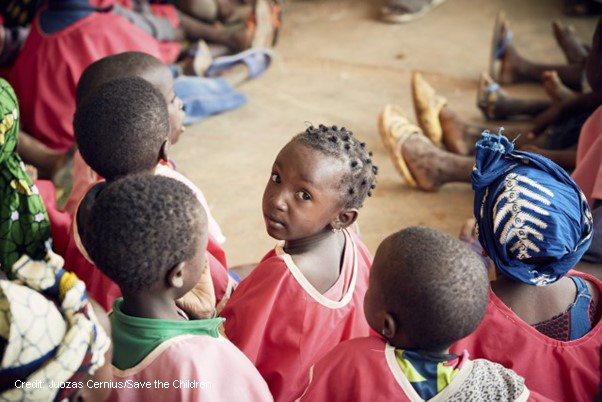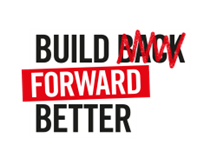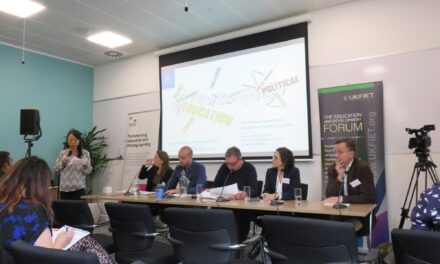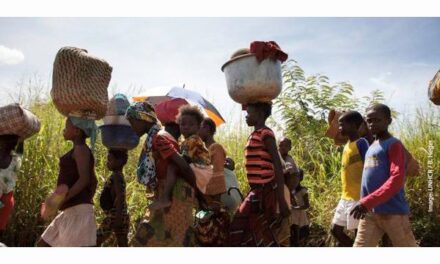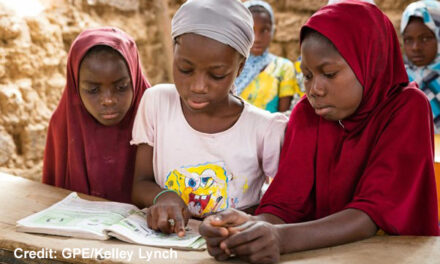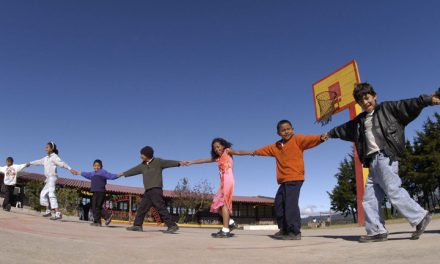This article was written by Bushra Zulfiqar, Global Education Director & Emma Wagner, Head of Education Policy & Advocacy, Save the Children. It was originally published on the Global Education Monitoring (GEM) Report’s World Education Blog on 6 September 2021.
“Because we dream of a better future, because we want to succeed, we want your support to make our voices heard and our demands realised. Be with us to create a strong and effective generation.” Mya, a girl from Lebanon
The education of hundreds of millions of children in 48 countries is at extreme or high risk of collapsing as factors such as climate change, lack of COVID-19 vaccines, displacement, attacks on schools and lack of digital connectivity are jeopardising their access to safe, inclusive and quality learning – unless action is taken now. Given the scale of the learning crisis that existed before the pandemic, it’s vital that we don’t limit our ambition to building ‘back’ to how things were. Now it’s imperative we Build Forward Better and differently.
Even before the Covid-19 global education emergency, 258 million school-aged children – one child in six – were already denied their right to education. Now, even more children are impacted by the learning crisis. In low-income, fragile and conflict-affected countries, the pandemic has compounded the education inequalities and discrimination so many children face.
Almost two years since COVID-19 first disrupted schooling in parts of Southeast Asia, no national education system in the world is back to ‘normal’. In the face of huge challenges, children have demonstrated remarkable resilience and agency. But the pandemic has had a devastating impact on their learning and wellbeing. We estimate that, because of the economic effects of COVID-19 alone, at least 10–16 million children are at risk of not returning to school, with girls worst affected.
The pandemic made the inter-dependencies between education, protection, health, nutrition and poverty in children’s lives increasingly apparent. And as a result, Save the Children adapted quickly by working across all sectors in an integrated way. We’ve learned how to respond holistically to crises and increase our impact for children.
In addition, the climate emergency, conflict and displacement are affecting education systems and economies. It is likely that the frequency and length of these kinds of crises are increasing.
The analysis in our new Build Forward Better report released today shows which education systems are most vulnerable to existing risks and future crises. Education systems in a quarter (48) of the world’s countries are at ‘extreme’ or ‘high’ risk of collapse, with the Democratic Republic of the Congo, Nigeria, Somalia, Afghanistan, South Sudan, Sudan, Mali, and Libya at extreme risk, closely followed by Syria and Yemen.
This list of countries won’t be surprising. These countries’ education systems need urgent attention and resources from national governments and international actors to prevent full blown crises.
| This report was written before the recent escalation in Afghanistan. Save the Children has been helping children in Afghanistan for over 40 years. We won’t be stopping now. Since May, over 250,000 people have been displaced. Hunger levels are rising. All children have a right to live in a world free from violence, to be able to go to school, to play with their friends and feel safe within their families and communities. Safe passage to deliver lifesaving services in Afghanistan must be ensured for front line workers who, even amidst the chaos, tell us they want to go back to serving their communities, as doctors, nurses and teachers, among many other vital roles. |
The idea of ‘building back better’ has long been applied to responding to crises globally – and is being used frequently today. But we must question the foundations of the education systems that have proven so fragile in the face of this level of disruption. We must also recognise that this crisis is an opportunity for hope and positive change.
Our Build Forward Better report explains what Save the Children and others have learned from the response to this pandemic. And what needs to happen now to ensure that education systems are better prepared, resilient and inclusive as they respond.
The pandemic has highlighted the need for iterative planning that is flexible enough to allow for anticipatory action based on forecasted or real-time data. Today, we can predict with increasing confidence the occurrence and potential impact of certain climatic shocks, political and conflict dynamics, and communicable diseases. The available data can help decision-makers agree to release pre-arranged funds for pre-agreed interventions that take place before such shocks occur to mitigate their impact.
By taking this anticipatory approach – using analysis of risk as well as need – ministries of education, along with the humanitarian community, can better realise children’s right to safe, quality education. Ministries of education should do this by institutionalising risk reduction and management in education planning processes – a process known as crisis-sensitive education planning. Technical and financial partners should support a country’s ministry of education, aligning short-term interventions with the ministry’s medium- and long-term objectives and activities.
The following 8-point plan brings together ten lessons learned from the COVID-19 integrated response and the actions required to deliver them (detailed in the report). This plan should urgently be adopted by low- and middle-income governments, donor governments, international agencies and funders, civil society, the private sector, and philanthropy to build forward better education systems.
- COVID-19 recovery: Ensure children can return to school safely and get their learning back on track.
- Preparedness: Every country must have a preparedness plan to secure children’s learning and wellbeing in future crises.
- Target out-of-school children: Ensure children who face discrimination and were out of school before the pandemic can access safe learning opportunities.
- Keep learning safe: Protect learning from violence and attacks, and from the impact of the climate emergency.
- Scale up and adapt financing: Urgently fill the education financing gap and adjust financing modalities to enable anticipatory action.
- Get the data right: Collect more and improved data for agile decision-making.
- Focus on equity and child participation: Reach the children most affected by inequality and discrimination first and include children in analysing, designing, implementing and evaluating programmes.
- Shift power: Move decision-making power and resources to national and local civil society.
Register for an event on 8 September 2pm UK time to hear more about the report.

